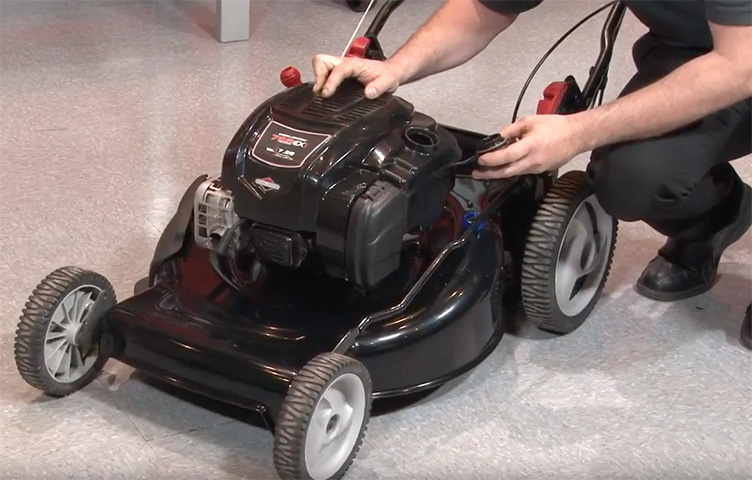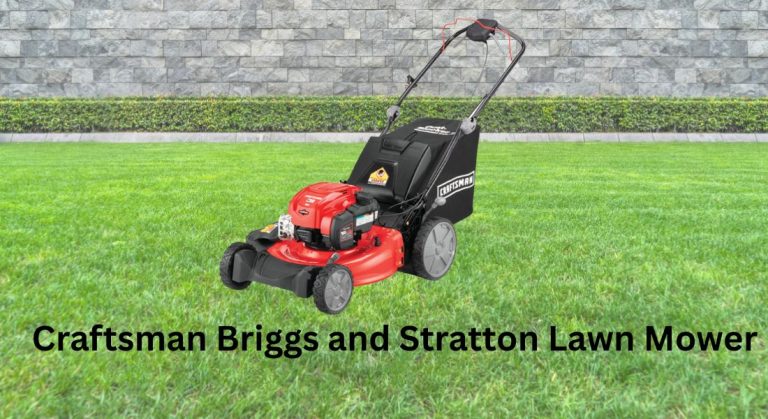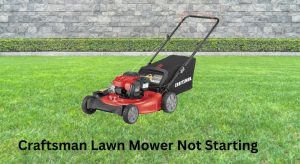Your Craftsman Briggs & Stratton lawn mower not starting is frustrating—especially when the grass won’t wait. The quickest fix for many starting issues is simple: check the fuel. If the gas is older than 30 days, drain and replace it with fresh, ethanol-free fuel if possible, and spray a small amount of carburetor cleaner into the air intake before pulling the cord. This often gets the engine to fire and helps diagnose a fuel delivery problem.
In this comprehensive guide, you’ll learn all the common causes and exact steps to fix a Craftsman mower with a Briggs & Stratton engine that won’t start. We’ll cover fuel, spark, air, safety switches, carburetor, battery (for electric start), and compression issues. By the end, you’ll have multiple solutions—from quick checks to deeper repairs—to get your mower running reliably again.
Common Causes of a Craftsman Briggs & Stratton Mower Not Starting

- Stale or contaminated fuel
- Clogged carburetor or jets
- Flooded engine
- Dirty or damaged spark plug
- Disconnected or faulty spark plug wire/coil
- Blocked air filter
- Engaged safety switch (blade/handlebar/seat on riders)
- Dead battery (electric start models) or bad solenoid
- Fuel line blockage or faulty fuel filter
- Stuck choke or faulty auto-choke
- Sheared flywheel key (after hitting an object)
- Low oil level triggering engine protection (some models)
- Compression problems (worn rings, valves)
- Water in fuel from ethanol phase separation
How to Fix a Craftsman Briggs & Stratton Lawn Mower That Won’t Start

Method 1: Quick Checks and Fast Wins (5–10 minutes)
Diagnosing the Issue
- Best for: Mowers that suddenly won’t start after sitting a few weeks.
- Signs: No start or brief sputter, smell of stale fuel, dirty plug or filter.
Fix Steps
1) Safety First
– Move to a flat, ventilated area.
– Pull the spark plug boot off to prevent accidental start.
– For riding mowers, set parking brake and disengage blades.
2) Check the Fuel
– If fuel is older than 30 days, drain the tank and carb bowl if accessible.
– Refill with fresh 87+ octane fuel; ethanol-free is ideal.
– Optional: Add a fuel system cleaner (e.g., Gumout/Sea Foam) per label.
3) Prime/Choke Correctly
– Push primer bulb 3–5 times (primer models).
– For auto-choke models, ensure the air vane/linkage moves freely.
– For manual choke, set to full choke for cold start.
4) Air Filter Check
– Remove the air filter cover.
– If paper filter is dark or clogged, replace; if foam pre-filter is oily/dirty, wash with warm soapy water, dry fully, and lightly oil.
– Try starting once with filter temporarily removed to test airflow (don’t mow this way).
5) Spark Plug Quick Clean
– Remove spark plug (typically 13/16″ socket).
– Inspect for carbon, oil, or cracked porcelain.
– Clean with a wire brush, gap to 0.020″–0.030″ (check your model manual), and reinstall snugly.
6) Use Carb Cleaner for a Quick Test
– Spray a 1–2 second burst of carb cleaner into the air intake.
– Reattach the plug wire and try to start.
– If engine fires briefly, you likely have a fuel delivery/carb issue.
Testing
- If it starts and stays running: you solved it.
- If it sputters then dies: proceed to carburetor cleaning.
- If no reaction at all: check for spark and safety switches next.
Method 2: Verify Spark and Safety Interlocks (10–15 minutes)
Diagnosing the Issue
- Best for: Pull cord feels normal, fuel is fresh, no signs of firing.
- Signs: Zero sputter with carb cleaner; safety lever not fully engaged.
Fix Steps
1) Check Spark Plug and Wire
– Remove the plug, reconnect the boot, ground the plug thread to metal on the engine, and pull the starter.
– Look for a strong blue spark.
– No spark? Try a new plug (cheap and quick). Still no spark? Suspect ignition coil or a kill switch grounding issue.
2) Inspect Kill Switch/Safety Interlocks
– Walk-behind mowers: Ensure the bail/handlebar safety lever is fully pulled back; cable should have tension. Adjust cable if loose.
– Riding mowers: Sit on the seat, brake engaged, PTO/blade switch OFF, transmission in neutral. Faulty seat, brake, or PTO switches will block starting.
3) Test the Coil Kill Wire
– On many Briggs engines, a single small wire grounds the coil to stop the engine. Disconnect this kill wire from the coil temporarily.
– Try to start. If you now have spark, a safety switch or wiring is grounding the coil; trace and repair.
– Important: If the engine starts with the kill wire disconnected, you’ll need to manually choke it to stop or reconnect the wire—proceed carefully.
4) Battery and Starter (Electric Start)
– Measure battery: 12.6V+ is fully charged; under 12.2V is low.
– Clean terminals, charge battery; try a known-good battery if needed.
– Click but no crank: check solenoid and starter motor; ensure ground cable connection to frame/engine is clean.
Testing
- Confirm consistent spark.
- If spark is good but no start with carb cleaner, check compression and flywheel key.
Method 3: Fuel System and Carburetor Cleaning (30–90 minutes)
Diagnosing the Issue
- Best for: Engine fires on carb cleaner but won’t run; sat with ethanol fuel.
- Signs: Primer bulb ineffective, fuel bowl varnish, surging before stall.
Fix Steps
1) Drain Old Fuel and Inspect Lines
– Clamp the fuel line, remove from carb, and drain the tank.
– Replace brittle or cracked fuel line.
– If present, replace in-line fuel filter (arrow toward carb).
2) Remove and Clean the Carburetor
– Common Briggs models use Nikki, Walbro, or Pulsa-Jet carbs.
– Remove air filter assembly, throttle/choke linkages, and mounting bolts.
– Carefully drop the float bowl (10mm bolt usually).
– Note: The bowl bolt often doubles as the main jet; its tiny side holes clog easily.
3) Clean Jets and Passages
– Spray carb cleaner through the main jet, emulsion tube, idle jet, and passages.
– Use a soft wire or bristle to clear tiny orifices—do not enlarge.
– Ensure float moves freely and the needle valve isn’t stuck. Replace needle/seat if worn.
4) Inspect Float and Gaskets
– Check float for fuel inside (leak)—replace if heavy.
– Replace bowl gasket and O-rings; ethanol swells old rubber.
– If your carb has a primer bulb, inspect for cracks; replace if air leaks.
5) Reassemble and Set
– Reinstall carb, linkages, and gaskets in correct order.
– Ensure governor spring/link is reconnected in the same holes.
– Add fresh fuel; prime per model instructions.
Testing
- Start the mower. It should run smoothly.
- If it surges or hunts, adjust the idle mixture (if adjustable) or re-clean idle circuit.
- Persistent issues may require a full carb rebuild kit or a new carb (often $20–$60).
Method 4: Air, Compression, and Timing Checks (20–45 minutes)
Diagnosing the Issue
- Best for: Good spark and clean carb but still no start.
- Signs: Very easy pull cord (low compression), backfire through carb/muffler.
Fix Steps
1) Air Filter and Intake
– Verify new/clean filter.
– Check for mouse nests/debris in shroud or intake path.
2) Oil Level and Low-Oil Shutdown
– Check oil level on flat ground; top up with SAE 30 or 10W-30 per manual.
– Some Briggs models won’t start if oil is too low.
3) Check for Flooding
– Remove spark plug; if wet with fuel, the engine is flooded.
– Open throttle, turn off choke, pull cord 5–10 times to clear.
– Let plug dry or replace, then try starting correctly.
4) Inspect Flywheel Key (after sudden stop or blade impact)
– Remove the starter shroud and flywheel nut.
– Check the soft metal key that aligns flywheel to crank.
– If sheared or half-moon displaced, replace key (cheap part) and torque flywheel nut to spec (usually 55–65 ft-lb for many small engines—confirm for your model).
5) Compression and Valve Checks
– Use a compression gauge; most small Briggs engines should show roughly 60–100+ psi depending on compression release.
– Very low compression: check for a stuck valve. Remove valve cover (OHV models), ensure valves move freely, set valve lash to spec (often intake 0.004–0.006″, exhaust 0.006–0.008″—confirm your model).
– If compression remains poor, rings/cylinder may be worn—consider professional service.
Testing
- After replacing a flywheel key or setting valves, the engine should start and run smoothly without backfire.
How to Prevent Future Starting Issues
- Use fresh fuel; avoid ethanol where possible.
- Add fuel stabilizer if fuel will sit more than 30 days.
- Run the engine dry at season’s end or drain the carburetor bowl.
- Replace air filter and spark plug annually.
- Change oil per schedule (usually every 25–50 hours).
- Clean debris from cooling fins and under the deck to prevent overheating.
- Keep battery on a maintainer (riders/electric start) during off-season.
Pro Tips
- Prime count matters: Over-priming floods the engine; under-priming causes hard starts. Start with 3–5 pushes.
- Store fuel properly: Use a sealed, approved container kept cool and dry; rotate stock within 60 days.
- Ethanol warning: E10 absorbs moisture leading to phase separation—use ethanol-free where available for small engines.
- Torque spark plugs correctly: Overtightening damages threads; use 180–220 in-lbs (check spec) or snug plus 1/4 turn for new gasket plugs.
- Replace cheap parts first: Spark plug, air filter, fuel line, and bowl gasket are low-cost and solve many issues.
- Label linkages: Snap a quick photo before removing carb linkages and springs to avoid misrouting.
- Keep blades sharp and balanced: Reduced load makes starting easier and improves engine longevity.
Professional Help: When to Call a Pro
- No spark after replacing plug and checking kill circuit—likely a bad ignition coil or wiring fault.
- Persistent fuel leaks from carb despite new needle/seat—possible warped carb body.
- Very low compression or loud knocking—internal engine wear or damage.
- Repeated flywheel key shearing—crankshaft or blade adapter issues.
- Electric start cranks slowly even with good battery—starter motor or internal binding.
What to look for in a service provider:
– Small-engine certification/experience with Briggs & Stratton.
– Transparent labor rates and diagnostic fees.
– Access to OEM parts and warranty processing.
Typical costs (varies by region):
– Carb clean/rebuild: $60–$120.
– Ignition coil replacement: $60–$150 parts/labor.
– Valve adjustment: $70–$140.
– Full carb replacement: $80–$160.
– Starter/solenoid diagnosis on riders: $60–$150.
Warranty considerations:
– Many Craftsman mowers carry limited warranties; using non-recommended fuel or neglecting maintenance can void coverage. Keep receipts and records.
FAQ
Q: My mower sputters but dies after a few seconds. What’s wrong?
A: It’s likely a fuel delivery issue—clogged main jet or restricted fuel flow. Clean the carburetor bowl and jet, replace the fuel filter/line if applicable, and try again.
Q: How do I know if fuel is stale?
A: Old gas smells sour/varnish-like and may appear darker. If it’s older than 30 days (without stabilizer), assume it’s stale and replace it.
Q: I have spark and fresh fuel, but it still won’t start. What next?
A: Try a short burst of carb cleaner into the intake. If it fires then dies, the carb/jet is clogged. If no reaction, check compression and flywheel key.
Q: The pull cord is very easy to pull and the engine won’t start. Why?
A: That suggests low compression—stuck valve, blown head gasket (less common), or worn rings. Check valve movement and set valve lash; perform a compression test.
Q: My electric-start Craftsman clicks but won’t crank. Fix?
A: Charge or replace the battery, clean terminals, check the solenoid, and verify the ground cable connection to the engine. If voltage drops below ~10V while cranking, suspect a weak battery or starter.
Q: Should I use fuel stabilizer?
A: Yes—especially if fuel may sit longer than 30 days. Stabilizer helps prevent varnish and phase separation that clogs jets.
Q: What spark plug should I use?
A: Many Briggs & Stratton walk-behind engines use RJ19LM or equivalent; OHV models often use BPR6ES-equivalents. Verify your exact engine model number (stamped on the blower housing or valve cover) and consult Briggs & Stratton’s plug chart.
Q: How often should I service the carburetor?
A: There’s no fixed interval, but if you store fuel with stabilizer and run the engine monthly, you may never need a deep clean. Otherwise, expect a clean/rebuild every 1–3 seasons if using ethanol fuel.
Alternative Solutions

If repeated carburetor issues persist, consider these options:
| Solution | Pros | Cons | Best For |
|---|---|---|---|
| Ethanol-free fuel | Reduces varnish and moisture issues | Higher cost, limited availability | Seasonal/occasional use mowers |
| Inline fuel shutoff valve | Allows you to run carb dry after mowing | Minor install effort | Long-term storage, transport |
| New OEM carburetor | Fast, often under $60, immediate improvement | Slightly higher cost than rebuild | Severely gummed or warped carbs |
| Upgraded coil and plug | Stronger spark, easier starts | Cost vs. benefit varies | Cold climates, hard-start engines |
Get Your Craftsman Mower Working Again
Follow these steps to fix your Craftsman Briggs & Stratton lawn mower not starting:
– Quick wins: fresh fuel, correct choke/prime, clean air filter, and a new spark plug.
– Spark and safety: verify strong spark, check kill wire, and ensure safety switches are engaged.
– Fuel system: drain stale gas, clean or replace the carburetor, and replace fuel lines/filters.
– Advanced checks: inspect flywheel key, set valve lash, and confirm compression.
Don’t let a no-start ruin your mowing day. Work through these solutions in order, and you’ll have your mower running smoothly again.
Have you tried these methods? Share your results in the comments below. Found this helpful? Bookmark it for your next tune-up. Still stuck? Describe your model and symptoms for tailored advice.




